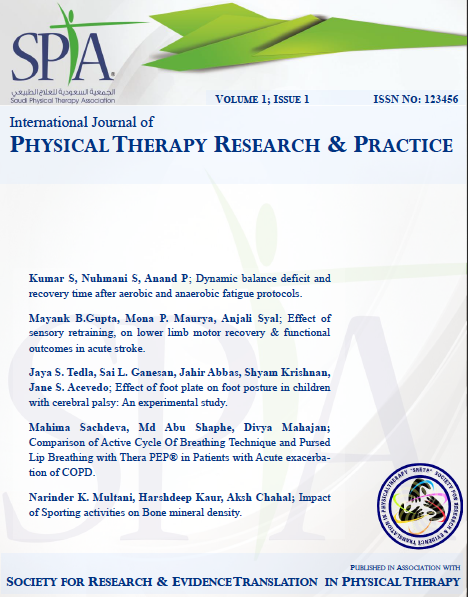Evaluating the Feasibility and Acceptability of Nintendo Switch-Based Exergaming for Enhancing Physical Activity in Children with Down Syndrome: A Pilot Study
DOI:
https://doi.org/10.62464/ijoprp.v4i7.120Keywords:
Exergaming, Down syndrome, Applicability, Video game, Motor FunctionAbstract
Objective: Nintendo Switch-based exergaming is increasingly used in therapeutic settings. This study aimed to determine whether selected Nintendo Switch games are feasible and engaging for children with Down syndrome (DS). Methods: This interventional pilot study included a convenience sample of 11 children diagnosed with DS. it involved a 40-minute exergaming session using a Nintendo Switch console with ten games (two sports and eight Family Trainer) that required weight shifting and stepping tasks based on previous studies. After the session, the validated Video Game Applicability Questionnaire was used to evaluate usability, engagement, and enjoyment of the selected games using a five-point visual Likert scale. Results: Data from 11 children (7 females), aged 10.45 ± 1.75 years, were analyzed. Games such as Timber Trail (M = 4.96, SD = .07), Log Leaper (M = 4.94, SD = .12), Jump Rope (M = 4.92, SD = .12), Sprint Challenge (M = 4.90, SD = .18), and Head on Hurdler (M = 4.90, SD = .18) received consistently high ratings for usability, engagement, and enjoyment, while others such as Mine Cart Adventure (M = 1.16, SD = .40), Mountain Boarder (M = 1.32, SD = .28), Mole Madness (M = 1.77, SD = .97), Golf (M = 1.77, SD = .76), and Soccer (M = 2.19, SD = .44) were rated lower scores across all domains. Conclusion: Several games showed potential for therapeutic exergaming in children with DS, emphasizing the need for further research and long-term trials.
References
Alba-Rueda, A., Moral-Munoz, J. A., De Miguel-Rubio, A., & Lucena-Anton, D. (2022). Exergaming for physical therapy in patients with down syndrome: A systematic review and meta-analysis of randomized-controlled trials. Games for Health Journal, 11(2), 67–78.
Álvareza, N. G., Mortecinosb, A. V., Rodríguezb, V. Z., Fontanillab, M. L., Vásquezb, M. M., Pavez-Adasmea, G., & Hernández-Mosqueiraa, C. (2018). Effect of an intervention based on virtual reality on motor development and postural control in children with Down Syndrome. Revista Chilena de Pediatria, 89, 747–752.
Antonarakis, S. E., Skotko, B. G., Rafii, M. S., Strydom, A., Pape, S. E., Bianchi, D. W., Sherman, S. L., & Reeves, R. H. (2020). Down syndrome. Nature Reviews Disease Primers, 6(1), 9.
Berg, P., Becker, T., Martian, A., Danielle, P. K., & Wingen, J. (2012). Motor control outcomes following Nintendo Wii use by a child with Down syndrome. Pediatric Physical Therapy, 24(1), 78–84.
Corey, J., Tsai, J., Mhadeshwar, A., Srinivasan, S., & Bhat, A. (2025). Digital motor intervention effects on physical activity performance of individuals with developmental disabilities: a systematic review. Disability and rehabilitation, 47(10), 2475–2490.
Esbensen, A. J., Schworer, E. K., & Hartley, S. L. (2024). Down Syndrome. In M. G. Valdovinos (Ed.), Intellectual and Developmental Disabilities: A Dynamic Systems Approach (pp. 279–302). Springer Nature Switzerland. https://doi.org/10.1007/978-3-031-66932-3_13
Ghafar, M. A. A., & Abdelraouf, O. R. (2017). Effect of virtual reality versus traditional physical therapy on functional balance in children with down syndrome: A randomized comparative study. International Journal of Physiotherapy and Research, 5, 2088–2094.
Gras, L. Z., Hummer, A. D., & Hine, E. R. (2009). Reliability and validity of the Nintendo Wii Fit. The journal Journal of CyberTherapy & Rehabilitation, 2, 329–335.
Halton, J. (2010). Rehabilitation with the Nintendo Wii: Experiences at a rehabilitation hospital. Occupational therapy now, 12(3), 11–14.
Machado, F. A., & Denadai, B. S. (2011). Validity of maximum heart rate prediction equations for children and adolescents. Arquivos brasileiros de cardiologia, 97, 136–140.
Michalsen, H. (2024). Encouraging participation in physical activity for individuals with intellectual disability: motivational factors, barriers, and mHealth applications UiT The Arctic University of Norway].
Parker, J. (2007). Games for physical activity: A preliminary examination of the Nintendo Wii. on Computer Science in Sport Calgary.
Prena, K., & Sherry, J. L. (2018). Parental perspectives on video game genre preferences and motivations of children with Down syndrome. Journal of enabling technologies, 12(1), 1–9.
Rahman, S. A., & Rahman, A. (2010). Efficacy of virtual reality-based therapy on balance in children with Down syndrome. World Applied Sciences Journal, 10(3), 254–261.
Shaheen, A. A., Masoud, A. E., & Alaggabani, M. F. (2023). Examination of the applicability and intensity of Nintendo Wiitm exergaming for children with acute lymphoblastic leukemia: a preliminary study.
Sukserm, P. (2024). Determining the Appropriate Sample Size in EFL Pilot Studies. Journal of Research Methodology, 37(3), 245–264.
Timaná Sr, L. C. R., García Sr, J. F. C., Bastos Filho Sr, T. F., González Sr, A. A. O., Rocio, N., Monsalve, H., Delgado Sr, C. A. N., & Valencia, N. J. ( 2024). Use of serious games in intervention of executive functions and children with Down Syndrome: A systematic review. JMIR Serious Games.
Wuang, Y. P., Chiang, C. S., Su, C. Y., & Wang, C. (2011). Effectiveness of virtual reality using Wii gaming technology in children with Down syndrome. Research in developmental disabilities, 32(1), 312–321.

Downloads
Published
Issue
Section
License
Copyright (c) 2025 International Journal of Physical Therapy Research & Practice

This work is licensed under a Creative Commons Attribution-NonCommercial-NoDerivatives 4.0 International License.



